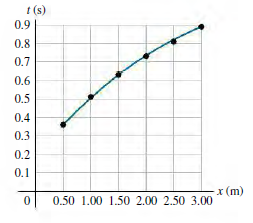In your physics lab you release a small glider from rest at various points on a long,
Question:
(a) How can you re-graph the data so that the data points fall close to a straight line? You might want to plot x or t, or both, raised to some power.
(b) Construct the graph you described in part (a) and find the equation for the straight line that is the best fit to the data points.
(c) Use the straightline fit from part (b) to calculate the acceleration of the glider.
(d) The glider is released at a distance x = 1.35 m from the bottom of the track. Use the acceleration value you obtained in part (c) to calculate the speed of the glider when it reaches the bottom of the track.
Figure P2.84

Fantastic news! We've Found the answer you've been seeking!
Step by Step Answer:
Related Book For 

University Physics with Modern Physics
ISBN: 978-0133977981
14th edition
Authors: Hugh D. Young, Roger A. Freedman
Question Posted:





